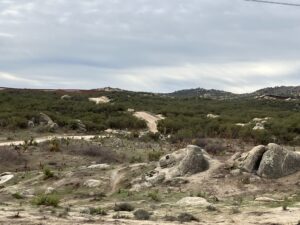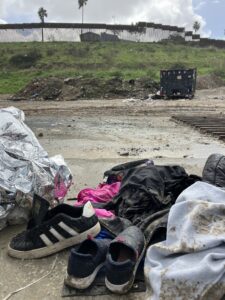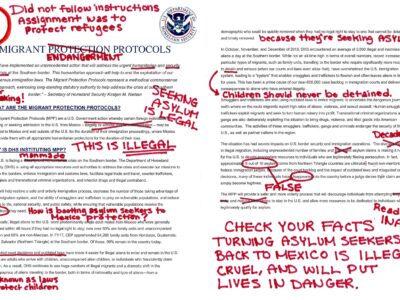U.S. Policies Punish Refugees at the Border
It was midnight and two mothers stood in heavy rain clutching their eight- and ten-month-old infants in cold, soaked blankets. The late-January temperature just south of San Diego hovered in the low 50s. They stood in the mud, trapped in the open-air detention site between two border walls where Border Patrol officers leave migrants to wait.

The border wall at San Ysidro
In similar weather at the same spot a week before, a volunteer witnessed a flash flood’s fast-moving water threaten to carry an eight-year-old child away from her migrant family. Through the wall’s steel beams, the volunteer shouted for the migrants to seek higher ground. The father carried his daughter through knee-high water to a nearby hill.
On this night, the rain continued. The mothers waited twelve hours – all night.
At 7 a.m. Border Patrol started to line up everyone to be taken for processing. A volunteer arrived and provided those waiting their first relief: dry blankets, water, snacks.
I stood in that mud just shortly after they left. I could see the outlet mall with the Coach store and Starbucks just past the San Ysidro land border crossing, less than two miles away. It’s the same land border crossing I had used the day before to cross into Mexico. These mothers, and thousands of others, can’t. Without appointments, they are blocked from entering the U.S. through that safe port of entry and U.S policies force them into perilous crossings through the border wall, river, or desert.
Blocked from safe entry to the United States
When the Title 42 expulsions policy expired last spring, the administration put in place a new asylum ban. This policy subjects people seeking asylum to penalties that risk returning them to harm if they enter at land ports of entry or cross irregularly without a limited, lottery-based appointment obtained through an inequitable smartphone app called CBP One.
Since the ban took effect, Mexican authorities have illegally blocked people without CBP One appointments from approaching southwest border ports of entry. At the same time, Customs and Border Protection (CBP) capped the number of CBP One appointments available and limited to less than 100 people per day the processing of those without appointments across the entire southwest border. The number of people without appointments who can access asylum can practically be considered to be zero.
I’ve spoken with people seeking asylum protection in the border cities of Texas, Arizona, and California, most recently in San Diego and an hour east at the Jacumba desert border. Many people who enter irregularly – outside of ports of entry – do so due to blocked access at ports of entry, lack of knowledge of the CBP One app, inability to use it due to language and other barriers, life-threatening risks from Mexican authorities and cartels, and urgent medical needs.
A Sikh man fled India due to threats he faced because of his political beliefs and opposition to the ruling party. He spoke in Hindi with my colleague shortly after crossing into the United States through the Jacumba desert. He was unaware of the CBP One app, which he wouldn’t have been able to operate anyway, as the government has made it available only in English, Spanish, and Haitian Creole. He also did not know that because of where he entered and his failure to use the app, he would risk being barred from asylum in the United States under the asylum ban.
Risking return to persecution and death
The stakes are high for people in need of asylum protection. Many are fleeing political or religious persecution, some seek safety from attacks that stem from their sexual orientation or gender identity, others must leave their homes to escape racial or ethnic oppression.
The asylum ban punishes them all based on how they enter the United States and whether they know of or can use the CBP One smartphone app. Despite the merits of their claims, bona fide refugees risk being barred from seeking asylum and returned to persecution.
After the fall of Kabul to the Taliban, three Hazara men, a persecuted ethnic and religious minority, fled Afghanistan. They crossed irregularly into the United States and turned themselves in to seek asylum protection. When we spoke to these men, they told usin Dari that they were unfamiliar with the CBP One appointment system, which is not available in their native language. Under the asylum ban, they now risked being returned to their deaths in Afghanistan.
At a welcome center in San Diego, I explained the asylum ban’s penalties to a Ghanaian man who entered the United States irregularly after being beaten, tased, and robbed by Mexican authorities in Mexico. He worried, “I am a member of the LGBT community. I need asylum protection. I cannot return to Ghana.” He explained that his pursuit of protection is based on a proposed law before the Ghanaian parliament that will further crackdown on LGBTQ rights and criminalize people who identify as LGBTQ or as LGBTQ allies, impose heavier criminal penalties on same sex activities, and prosecute people that support, fund, or publicly advocate for LGBTQ+ rights.
Many people fleeing persecution have no knowledge of the CBP One app and come from regions of the world where the three languages on which the government centered the CBP One app are foreign tongues. In our research, we found that Black asylum seekers from African countries who crossed the border into California had no knowledge of the app, though most would not have been able to use it due to language barriers.
Forced to wait in perilous and inhumane conditions

The The Jacumba, CA desert
It was just below freezing on a late January night near the border wall in the Jacumba desert. Asylum seekers and migrants, restricted from ports of entry, have made this patch of desert a well-trod corridor toward turning themselves in to Border Patrol.
At about ten p.m., a group of families and adults crossed to the United States. They waited without shelter, blankets, food, or water for Border Patrol to apprehend them. And they waited. Ten punishing hours later, Border Patrol arrived and separated people by sex: mothers from their adult sons, a wife from her husband, and they took the women for processing.
A Turkish asylum seeker used Google translate to tell us, “They [Border Patrol] don’t understand our language, and how we are related, so our family got separated.” A Chinese man asked us, “How do I find my mom?”
A volunteer told me of the heavy winter rains of the prior week, and how Border Patrol left people seeking asylum to wait outside in the bitter rain for five to six hours. Volunteers told of their repeated efforts to set up tents, shelters, and tarps. They said that in December, before the rainy season began, someone had removed the structures.

Migrant children’s belongings left in the mud
For several months at the end of last year, Border Patrol forced hundreds of people to wait outdoors for several hours or days at several open-air detention sites along the Jacumba desert and near the San Ysidro border. These asylum seekers were not provided adequate access to water, food, sanitation, medical care, or shelter.
Several refugee advocacy groups filed a complaint with the Department of Homeland Security’s Office for Civil Rights and Civil Liberties about this gross abrogation of these asylum seekers’ rights and of federal refugee law. Forcing people to wait in dangerous and inhumane conditions for extended periods without basic humanitarian assistance and medical care violates CBP’s standards and risks lives.
“I’ve called 911 more times than I could imagine,” a volunteer shared. The volunteer called for help for a migrant man having a heart attack and a French-speaking woman from Angola who crossed with her three children into the desert in search of protection. Her diabetes-related edema of her feet led authorities to hospitalize her immediately.
It was nearly 10 a.m. as we joined local volunteers to walk the desert and handed out water bottles and granola bars to a group of over fifty asylum seekers and migrants from Azerbaijan, China, Russia, Turkey, and Uzbekistan. They neared their twelfth hour of exposure to the elements, waiting in the desert winter for Border Patrol to process them.
Using Google translate, we learned a few Chinese men were over sixty years old and in need of medical attention. One suffered from back pain so severe it prevented him from sitting. Most of this group knew nothing about the CBP One app – unsurprising because it is not available in Mandarin. One Chinese man explained, “I did not know how to fill out the application.”
Uphold the right to seek asylum
The asylum ban and related policies restrict access to ports of entry, condition access to asylum on use of a lottery-based appointment system, and punish refugees for their manner of entry. These policies risk the wrongful return of asylum seekers to persecution and violate U.S. and international refugee law. They are counterproductive policies that fail their intended goal, as they spur more irregular crossings of the U.S. border.
DHS must rescind the asylum ban. While it is deeply punitive, it cannot work as a deterrent because most asylum seekers and migrants are not only unaware of it, but cannot safely wait in Mexico where they are targeted for harm by some Mexican authorities and cartels. Their actions are overwhelmingly driven by urgent needs for immediate safety, shelter, and medical care. It is nonetheless likely that they will be returned to persecution, violence, or even death because of it.
DHS must instead maximize asylum processing at ports of entry: Nearly all asylum seekers I’ve spoken with all along the border prefer to enter the United States at ports of entry, where processes should be clear. No one wants to risk their life crossing irregularly; they do it because they must: access to safety is strongly restricted at the ports of entry, some are far from ports of entry or are brought to areas where there are no ports of entry and are instructed to cross.
DHS must also promptly process people who enter between ports of entry. They must provide critical humanitarian assistance, conduct life-saving triage, and provide medical care.
Finally, Congress must uphold the fundamental right to seek asylum protection, not barter with refugees’ lives. Expulsions policies, restrictions on access at ports of entry, and heightened eligibility standards violate core principles of the Refugee Convention and undercut 70 years of refugee protection.
My most recent trip to the border showed clearly where the U.S. government is failing people who seek asylum, how its policies put people at risk and violate human rights, and that our nation can do far better. Our advocacy on asylum will continue toward that goal.

